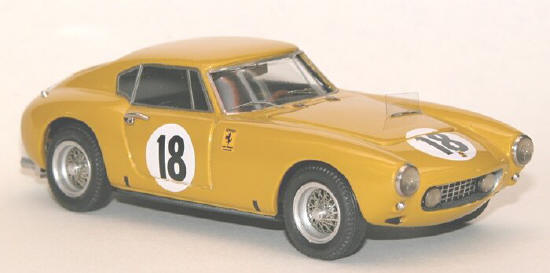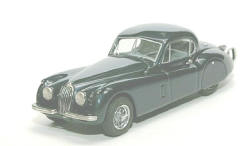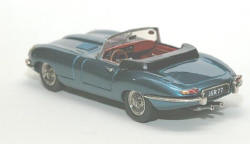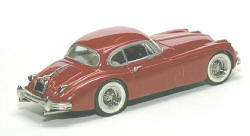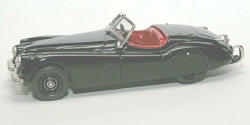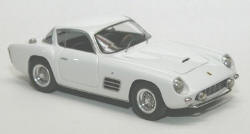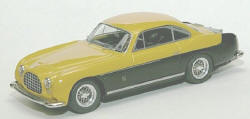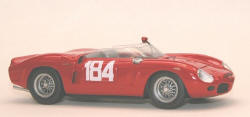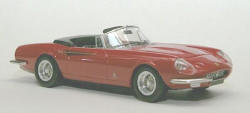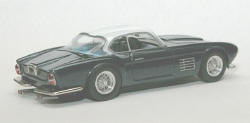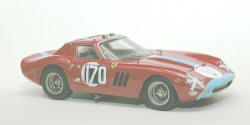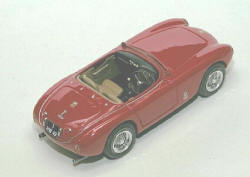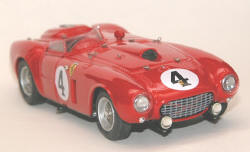|
Our thanks on this first French issue of Amazing43 to Marcel Brossi for conducting this interview with Andre- Marie Ruf perhaps the best known producer of white metal kits today.
Mr. Ruf, thank you for accepting this interview.
-At what age did you first show an interest in modeling? How many years did it take you in order to achieve your first models ?
If your interpretation of modeling is the same as mine..., i.e. modeling with all materials possible, reproducing miniature automobiles, trucks and tractors... Then, I started modeling at the age of 7 or 8. My biggest pleasure when I was a child was to make cars and motorcycles with "modeling putty". Even when I was sick and in bed, my mother would worry about get the "modeling putty" all over the bed sheets !
My revelation came when I first got a John Day kit. He created the 1:43 kit in white metal, back in 1970 in England. Even though I was the first to make white metal models in France since 1975, I consider John Day a master over all of us.
The Porsche Turbo RSR 1974 Le Mans, was the first AMR model and it took more than a year of work. At that time I was working for Renault and I had to learn everything about modeling and white metal. I had to find an smelter and learn how to do bronze(the master that will be casted), find suppliers for glass for the windshields, decals, paint, etc... It was a rich era of apprenticeship and many hours would be necessary to tell you all !
-In the USA, kits were and are still being made in big scales such as the 1:24 scale. Why have Europeans opted for the 1:43 scale ?
To respond with a little bit of humour, I would say that the size of collector's showcases are proportional with their size of country. The larger the country, the larger the models and vice versa. Seriously now, the 1:43 scale is linked with the first train layouts. They were O scale (presently at the HO/ 1:87 scale). The precursor of the automobile miniatures have adopted a scale to match train and car in the same diorama.
-How do you explain the multitude of craftsmen in France and Italy ?
It is the resin that has permitted this "multitude". Less costly and easier to work with compared to the white metal. When the handicraft kits market exploded, the resin raised many vocations at that time. Most of those who thought to make fortune with resin, have disappeared. The collectors have become more exigent and the industrial models have improved in quality.
-Have your methods of conception changed over the years, with the arrival of efficient machines ?
I'm not a partisan of the use of machines. I have tested a pantograph and I gave up. A model manufactured by a machine has no soul for me. I'm convinced that the value of a handmade object is closely connected with the manual work. Those who appreciate my work, claim to see an interpretation of the real automobile. My goal is to give to the 1:43 scale the same presence the 1:1 scale has.
This "caricature" of a miniature model brought by man and his hands, is what gives all the value of a handcrafted model. No machine would know how to replicate this. Those who think a handicraft model has imperfections... I'm convinced that an industrial model is cold because it is too perfect, consequently, without personality.
-Do you take advantage of some automobile manufacturers as they can provide you with plans, drawings or data like Herpa Miniaturemodell have access ?
Of course ! But nothing can replace the possibility of feeling the automobile by seeing it and taking pictures.
-With the Internet, has the work of a prototype accelerated because of the multitude of information available ?
Yes. With the condition to find reliable information and data. There are many cars that have been restored without respecting the original version, so we have to be cautious.
-Is there any car which you would like to reproduce, but due to the lack of documentation caused you any difficulties ?
Yes. For example, my attention to detail forced me to delay up to 6 months, the launch of a 365 GTB GrIV 24 Hours of Le Mans kit. In fact, I was enable to find a picture allowing me to read the inscription located on the rear bumper.
-Without any doubt, you are a Ferrari and Porsche fan. Have you ever met "Il Commandatore" ?
No. I didn't have this honor. I would like to met the Porsche preparator, Alois Ruf. Not only we do we share the same passion for Porsche, but we also have the same family name. Perhaps we have the same ancestors ?
-I have noted that you do not have any stereotype for modern cars, as you have made many of them. But have you a "fetish" era for cars ?
Probably from 1955 until 1985. Sport or road cars created in those 30 years have for me, a real personality. Maybe because they were the work of coach workers working aluminum and sheet-iron with a hammer, consequently, with their hands. Among my favorites are the 1960 SWB , the Countach, the F40 and the 1980 930 Turbo.
-A big range of your references, are racing subjects. Do you still like actual racing, where politics and money rule? Does it bother you ?
I have followed the 24 Hours of Le Mans from 1975 to 1992. At that time, it was easy to access the garages, met the crew and show my work and put an AMR decal on the real racing car. In exchange I would give AMR built models to the drivers, mechanics and official sponsors.
AMR was present when Rondeau won the 24 Hours of Le Mans in 1982. AMR was also present on the BB 512 of the Scuderia Bellancauto and on the Porsches 935 of Preston Henn in Daytona in 1983 and 1984. With the arrival of big teams sponsored by constructors, the passion and spirit have evaporated within the economic interest.
-Mr. Ruf, according to you, what are the best years of motor sport?
The 24 Hours of Le Mans, especially during the old style starts, which I never had the opportunity to see. During the 1975-1980 period, I have enjoyed the group IV and the Formula Silhouette. The BMWs that used to race in Belgium and Germany were very spectacular.
-The best drivers ?
It is hard to judge the technical qualities of drivers. But I have been impressed by Hans Stück in the rain. I had the opportunity to frequent and appreciate Bob Wollek, Pierre Dieudonné and Coco Chinetti.
-Your dream car ? Passionate as we are, it is perhaps a silly question. So, can you share your top-10?
There is no silly question ! My top-10 dream cars without any order are:
Porsche 930 Turbo of the 80's prepared by Alois Ruf
Lamborghini Miura SV or Jota
Ferrari Daytona Gr IV
Berlinetta Alpine A 110 1600 S (I have a 1970 Berlinetta 1300 G)
Jaguar MK2 3.8 L
Ferrari Dino 246 GT
AC Cobra 427
Triumph TR3 A
Mustang Shelby
Corvette Greenwood (84 model)
Dodge WC52 (yes, the car designed by the American army in the '40s)
-The actual AMR listing is dominated by Ferraris. My friends of the Lamborghini Club, would like to know if other references will make a return, or if others will be added to the AMR collection ?
I really want to complete the 350 GT Coupé, the spyder and the Countach that was made few years ago. Unfortunately, Lamborghinis and Alfas seems to be less appreciated by collectors, compared with the cars of Modena. Nothing is in the works for the moment.
-A question coming from a 1:43 discussion forum... Have you thought or have you any plans to launch the 1949 Ferrari 166 Le Mans, number 3 ?
Unfortunately, no.
-Another question coming from an admirator
a) The best stage while mounting a kit? And the one you most dislike ?
I don't built kits anymore since the late 70's. I have privileged the creation, I work the wax, bronze, and I draw the instructions. But I haven't forgotten that building a kit requires patience, technique, and a solid documentation. Even if the kits instructions are very well detailed, they can never replace a series of pictures to visualize the actual car.
b) What advice do you have for the modelers that are starting out (attitude and technique) ?
I believe that the secret of a well built model is in the preparation. One should take the necessary time on deburring, and the fitting prior to painting and gluing in order to achieve a perfect assembly.
-Are the modern automobiles harder to get licensing ?
For the moment, everything is fine.
-The photo-etched parts that are normally present in most kits today and a few years ago they were considered the ultimate detail. What will be the next innovation in the 1:43 scale ?
I'm glad that your asked me this question. I'm proud of being the first to introduce the photo-etching of wheels in a model kit. I believe that the windows are the next progress to be made. You have to find a formula between the formed lexan with photo-etching and the vacuum-formed.
-André-Marie Ruf, you have the opportunity and the talent to devote your full time to our passion. Do you have any other hobbies ?
Sometimes, I buy public vehicles in the 1:50 scale and when I find in France, ERTL tractors in 1:12 scale.
-How much time it takes to build a model ?
Being well organized, 8 to 10 hours would be a correct time, obviously, paint drying not included.
-Have you ever made something other than a automobile ?
I have made for shops and associations medals and jewels. For friends, I have made bracelets, brooches, elephants and probably more.
Can you tell us what are you working right now ?
I'm working on a second Titan. A 1981 BB 512 Le Mans that will be added to the collection this Autumn. The Daytona Gr. IV 1:12 scale which has been available since Spring 2003.
Any project in mind ?
I have a lot of projects. But to not inspire my colleagues and competitors, I prefer to wait until the project is quite advanced before any announcement.
Mr. Ruf, Merci Beaucoup !
Our regular contributor Rodney Rawlings has built many AMR subjects over the years. The pictures are just a few of the models he has built.
|
